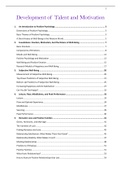Samenvatting
Development of Talent and Motivation - Summary
- Instelling
- Tilburg University (UVT)
- Boek
- Positive Psychology
This is an extensive summary for the course Development of Talent and Motivation, which is part of the Developmental Psychology major/ minor at Tilburg University. The summary covers all relevant chapters of the book "Positive Psychology" (3rd edition) by Compton and Hoffman, as well as all lecture...
[Meer zien]





